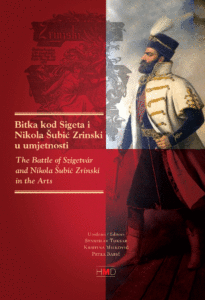Bitka kod Sigeta i Nikola Šubić Zrinski u umjetnosti (glazba, likovne umjetnosti, književnost)
The Impact of the Battle of Szigetvár and the Myth of Nikola Šubić Zrinski on the Arts (Music, Visual Arts, Literature)
Urednici / Editors: Stanislav Tuksar – Kristina Milković – Petra Babić
Muzikološki zbornici, br. 20
Hrvatsko muzikološko društvo / Croatian Musicological Society, 2018.
443 str./p.

Bitka kod Sigeta (1566.) predstavlja jednu od središnjih točaka hrvatske povijesti, jednako kao što je i zapovjednik utvrde, Nikola Šubić Zrinski, jedna od njezinih centralnih figura. Oni to nisu postali zbog toga što bi se bitka odvila na dotad nezabilježen način nego zahvaljujući nizu okolnosti zbog kojih je bitka u samo nekoliko godina nadrasla svoju povijesnu važnost i prerasla u mit koji je u narednim stoljećima gotovo neprekidno perpetuiran i osnaživan. Iako je ishod bio vojni poraz, moralna pobjeda branitelja postala je svojevrstan model samožrtvovanja za domovinu, narod i ideale koje se nastojalo usaditi u pojedince kako u proto-nacionalno vrijeme (do 19. stoljeća) tako i kada je nacija formirana kao primarno kulturna, a potom i politička zajednica (od 19. stoljeća nadalje).
Umjetnička produkcija na temu bitke i ličnosti Zrinskoga započela je gotovo odmah, ali do 19. stoljeća najbrojnije su bili narodne, didaktičke i junačke pjesme i spjevovi, dramski tekstovi te kroničarska djela. U 19. stoljeću primat preuzimaju glazbena (opere, marševi, simfonijske pjesme) i likovna djela (slike i kipovi). Tada je Zrinski postao i nacionalni simbol borbe za slobodu, čime je umjetnost koja ga tematizira ušla u sferu politike.
Ovaj Zbornik radova s istoimenog znanstvenog skupa održanog 2016. u Zagrebu sastoji se od 21 rada hrvatskih i tri rada inozemnih znanstvenika (iz Italije, Mađarske, SAD-a) što obuhvaćaju četiri područja (opća povijest, muzikologija, povijest umjetnosti i znanost o književnosti) i pokrivaju vremenski raspon od četiri stoljeća. Osobita je vrijednost to što je kroz pojedine radove prikazana internacionalna popularnost teme ne samo u 16. nego i u 19. stoljeću. Cilj simpozija nije bio rušenje mita o Nikoli Šubiću Zrinskom, nego registriranje njegova postojanja u različitim umjetničkim područjima, pri čemu ga se objašnjava u odnosu na unutar- ili izvan-umjetničke procese, vrlo često vezane uz razne političke diskurse i narative, koji su i pridonijeli njegovom nastanku.
* * *
The Battle of Szigetvár (1566) is considered to be one of the crucial points in Croatian history, as well as the commander of the fortress, Nikola Šubić Zrinski (in Hungarian: Zrinyi Miklós) is among its main historical figures. They both did not become what they have been ever since because the battle itself developed in an unusual way, but because owing to circumstances by which the battle, in only a couple of years, outgrew its historical importance and became a myth to be perpetuated and even strengthened in the centuries to come. Although the final issue was a military defeat, the moral victory of the Szigetvár defenders became a model of self-sacrifice for one’s own homeland, people and ideals which was intended to be implanted in the hearts and minds of individual members of a nation in both the proto-national times (before 19th century) and in the times when nations were formed as primary cultural and later also political communities (from 19th century on).
The production of artistic artefacts began almost immediately; however, throughout the period prior to the 19th century, folk, didactic and heroic poems and epics were the most numerous, followed by dramatic texts and chronicles. During the 19th century primacy passed to musical compositions (operas, marches, symphonic poems) and works of visual arts (paintings, sculptures). In this period Zrinski became also a national symbol in struggle for freedom, thus making art entering the sphere of politics.
This Proceedings contains 21 articles by Croatian and three articles by foreign scholars (from Italy, Hungary, USA), encompassing four areas (general history, musicology, art history and literary history) and covering a span of four centuries. Special value lies in the fact that single articles have shown international popularity of the topics under consideration not only in the 16th (which was already well known) but also in the 19th century. It should be pointed out that the aim of the conference was not the deconstruction of the Zrinski myth, but to gather under one roof works in various areas which contain it, and to try to explain it in relation to processes within the arts and outside of them, often related to political discourses and narratives, which contributed to its creation.
2018.
ISBN 978-953-6090-60-0
230,00 kn + poštarina

